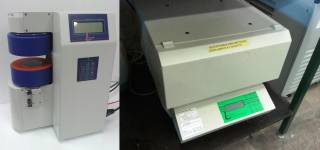
The research group has two heat meter flow instruments, FOX50 and FOX304. The instruments are used to study the thermal conductivity and specific heat capacity of materials. In the case of thermal conductivity the performance of the instruments is based on Fourier’s law. A sample is placed between two isothermal plates in different temperatures, which causes a ona-dimensional temperature gradient. Thermal conductivity is calculated with the temperature gradient and the heat flow rate through the sample. When determining the specific heat capacity the sample stores heat. The amount of heat is calculated by assuming that the values from the upper and lower plates are proportional to the heat flux density (W/m²) from or to the sample on the upper and lower surfaces multiplied by the time measured by the instrument. Specific heat capacity is calculated with the amount of heat, the change in temperature, and the thickness of the sample.
Samples placed in the FOX304-instrument are square, with a side length of 150-300 mm and a thickness of 0-102 mm. In the FOX50-instrument the samples are circular, with a diameter of 50-63 mm and a maximum thickness of 25 mm. When preparing a sample, attention should be paid to the smoothness of the surfaces. Especially in specific heat capacity experiments the unevenness of the sample surfaces significantly affects the results. Unevenness has negligible effects on the thermal conductivity results of insulation materials. FOX304 can also be used to do experiments of loose materials, which will be sprinkled into an EPS-frame with a plastic film on the top and bottom surfaces. In thermal conductivity experiments done according to the standard (SFS-EN 12667) the temperatures of the plates are 0 °C (upper plate) and 20 °C (lower plate). In standardised (ASTM C1784-13) specific heat capacity experiments the plate temperatures are 5 °C, 15 °C, 25 °C, 35 °C and 45 °C.
